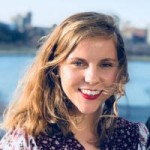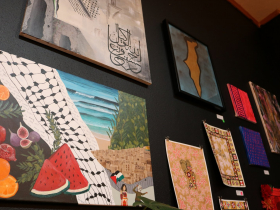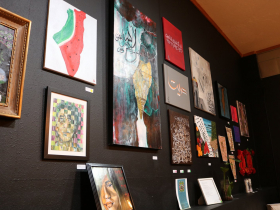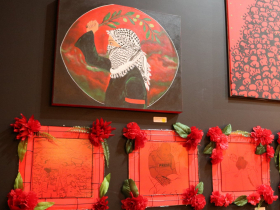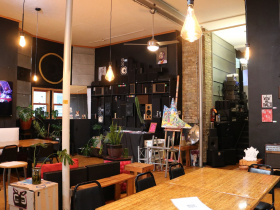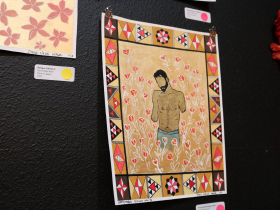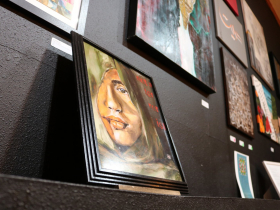Palestinian-Led Art Exhibition Raises $3,200 for Gaza
'For Palestine, For Humanity' launched Jan. 20, continues at The Gallery on the East Side.
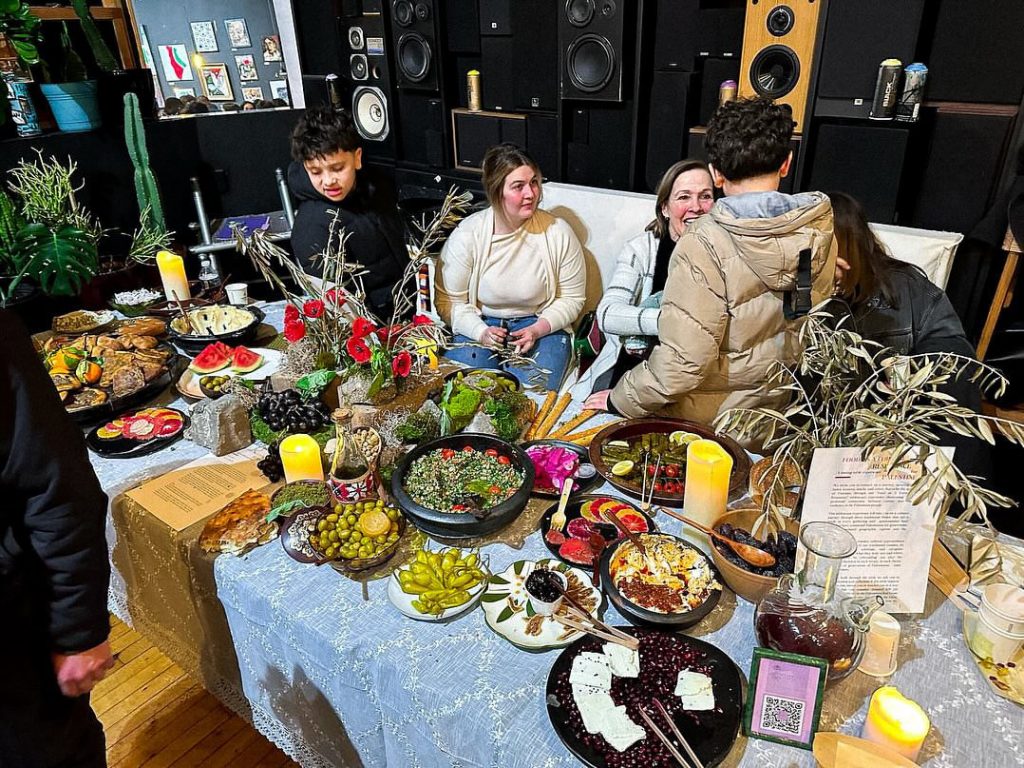
Muna Sharma prepared a tablescape for opening night of the For Palestine, For Humanity exhibition. Photo courtesy of Muna Sharma.
At Kamal Shkoukani‘s East Side eatery, The Gallery, creativity shines from both the menu and the walls. The business, which opened last summer, is equal parts restaurant and exhibition space, offering hot chicken, burgers, nachos and more with a side of local artwork.
A current installment focuses on the humanitarian crisis in Gaza, encompassing themes of resilience, pride, profound suffering and anger, all presented in a green, red, black and white color scheme. Dozens of works cover the walls, but almost none are for sale. At least, not anymore.
A painting of a keffiyeh-clad woman waving an olive branch, works of flowing calligraphy, gritty depictions of fallen cities, a vibrant slice of seeded watermelon — a symbol of Palestinian resistance — and dozens more were all purchased on Jan. 20, the show’s opening day.
In fact, most of the pieces, save for two paintings, were claimed during the first two hours of the exhibition, which raised a total of $3,200 for the Palestinian Red Crescent Society.
“It felt a little surreal, but it also felt like home,” said Amal Azzam, an artist and co-organizer of the installment, titled For Palestine, For Humanity. “People were there just to show support and to show love, and that’s really what I felt from the beginning until the end.”
Liala Amin, another local artist, partnered with Azzam to organize the exhibition. Both featured several of their own works at the event, along with submissions from others across the city.
With upwards of 200 people in attendance for opening night, Azzam said she was slightly taken aback by the turnout. The number of engaged attendees, she said, was evident not just in the checkout line, whose length snaked around the perimeter of the exhibition space, but also through guests’ attentiveness to speakers and their enjoyment of a traditional food spread from Muna Sharma, the chef, planner and creative mind behind Bint Jamila’s Table.
Like others featured in the exhibition, Sharma is an artist. Her medium, however, is food. “I tried different forms of art,” she said. “I was a photographer, I tried writing, but I never felt like anything could truly convey how I was feeling.”
Sharma eventually discovered that, through the multidimensional and rich sensory experience of food, she was able to achieve what had felt unattainable with paintbrushes and pencils. “I was able to bring a part of me to life that people could experience with all of their senses,” she said.
“You can smell it, you can see it, you can hear it with the crunch and the movement, you can taste it, you can touch it. And I felt like this was the best way for me to be able to convey myself as an artist, and to share bits and pieces of myself with the world.”
On opening night of For Palestine, For Humanity, Sharma presented an elaborate tablescape demonstrating “the profound connection between cuisine and the resilience of the Palestinian people.” The spread featured three main dishes, warak dawali (stuffed grape leaves), tabbouleh and fatayer (savory stuffed pastries), along with numerous accoutrements.
“Each of these dishes are not only meant to be shared and eaten in community, but they typically take a community to make,” Sharma said. “It’s a reflection of Palestinian food culture: we cook together in groups and also enjoy our food in groups.”
Nestled between the main dishes on the table were smaller plates of juicy citrus fruits, cheese, hummus, spicy labneh, taboon bread, ka’ek al-quds (sesame bread) and various pickles.
For dessert, Sharma served an assortment of watermelon-flavored candies — a big hit with the kids in attendance, she said — as well as apricot rolls and Alibaba chocolates, a nostalgic treat for many of the guests. Decorative olive fronds and red anemone blooms dotted the tablescape, contributing color and texture to the edible art piece.
Sharma said she chose each element of the tablescape with intention, selecting foods and plants that have been enmeshed in tradition for centuries. For those who formerly resided in Palestine, many of the items hold great significance, she said. “It’s what connects them to back home.”
Nearly two months after the event, Sharma said she’s left with feelings of hope and inspiration.
“Every single person showed up as they were with whatever capacity they had,” she said. “Some had bigger capacity than others, but we all showed up in our own way and just found comfort being surrounded by other people who saw our humanity.”
After years of feeling pressure to “suppress” her culture and heritage, Sharma said that creating and presenting the tablescape was both vulnerable and freeing.
“It feels like I finally am able to express myself in a way where I can show this part of myself — the Palestinian part,” she said. “It was something me and my mom did together. We showed the world a part of us and people loved it. People saw themselves in it.”
Other contributors expressed similar sentiments.
“I remember protesting about Palestine since I was a little kid, but this time around, it really seems like everyone’s coming out and showing support.” said Shkoukani, who hosted the art show. “I’d say there was more non-Palestinians than Palestinians here that night, which was amazing to see.”
Azzam added that she hopes the aftermath of the exhibition will continue to raise awareness about the crisis in Gaza while bridging connections between community members here in Milwaukee.
Looking ahead, Azzam said she will continue to create, process and express the complexities of her identity through art. She is an active member of Fanana Banana, a movement in support of Muslim, Middle Eastern and/or North African artists, which she co-founded with her partner, Nayfa Naji, in 2019.
For Palestine, For Humanity, was initially slated to remain in the East Side space for 60 days, but has been extended to last at least 90. Shkoukani said it will continue through April 9, the final day of Ramadan, if not longer. An official end date has not yet been announced.
The exhibition, located at 2335 N. Murray Ave., is available to view daily from 5 p.m. to 10 p.m.
For Palestine Cooking Workshop Series
Meanwhile, Sharma’s participation in the art exhibition has set in motion a series of food-focused gatherings. Her For Palestine Cooking Workshop Series launched on March 3 with an introduction to Palestinian stews, inviting a dozen guests to participate in the preparation and enjoyment of three homemade stews, seasoned rice, salad, pickles and dessert.
The next workshop, set for March 17, will explore the art of fermentation, an integral element of Palestinian cuisine and culture that Sharma said is also rooted in the struggle for liberation. “It’s one of the forms of resistance, of being able to preserve your food.”
Future workshops focused on cuisine, art and other elements of Palestinian culture will be announced on Sharma’s Instagram page.
Sharma’s mother, Jamila, plays an integral role in Bint Jamila’s Table. The name itself means Jamila’s daughter in Arabic, and Sharma couldn’t be prouder to carry that title.
“I am my mother’s daughter,” Sharma said. “She’s strong, she’s incredible, she’s beautiful, she’s powerful, she’s talented, she’s creative. And when it came time to name my company, I wanted the essence of my mom to be in everything that I did.”
Sharma also draws inspiration from upbringing in Al-Bireh, Palestine, where her family’s house was constantly full of guests. “We’re a small family of four, but our house never had less than 10 people in it.”
Beyond the workshop series, Sharma said she has big plans for Bint Jamila’s Table. The business will continue to function as a private event planner, with a number of additional projects in the works.
Meanwhile, Sharma said she hopes to continue growing the reach of Bint Jamila’s Table while using the business as a springboard for connection.
“I want this table to be an expression of all of us,” she said. “I see the future of Bint Jamila’s Table kind of going towards more of a communal table, working with different people — young people, older people, whoever is interested in sharing this part of themselves with the world, you have a table to do that.”
Photos
If you think stories like this are important, become a member of Urban Milwaukee and help support real, independent journalism. Plus you get some cool added benefits.

